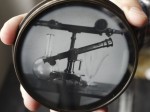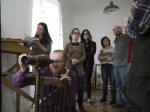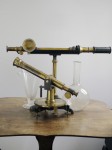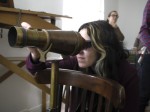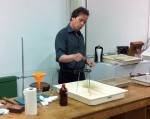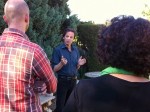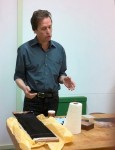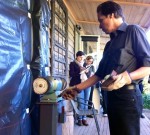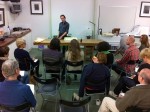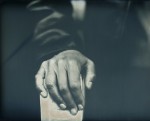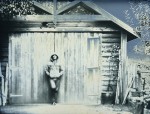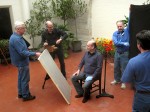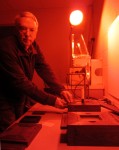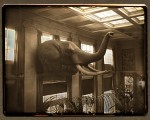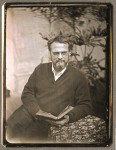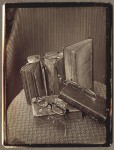Kaden Kratzer, a workshop participant at a recent Eastman house offering, sent in this account and images of the experience.


“In February I had the opportunity to attend the The Daguerreotype: History and Technique; a workshop at George Eastman House International Museum of Photography and Film in Rochester, NY. This mercurial daguerreotype Workshop was taught jointly by Mike Robinson and Mark Osterman. I had previously taken a Becquerel daguerreotype workshop, but I found the idea of demystifying the secrets of mercurial daguerreotype irresistible.
I am the sort of person you could classify as a serial photography workshop participant. Throughout the years I have attended workshops taught by many fine photographers at some great institutions.
The daguerreotype workshop at George Eastman House however was unlike any other workshop I have taken elsewhere and exceeded my expectations in a variety of ways.
Aside from two great teachers, we were able to inspect actual historic daguerreotype cameras and assorted processing equipment under the care of the Technology Curator Todd Gustavson. We also had access to amazingly beautiful daguerreotypes in the Eastman House collection, including my favorites by Southworth and Hawes. There was also a lecture on conservation and casing of daguerreotypes presented by Alice Carter from the conservation department.
The workshop was a four day event. Day one consisted of a comprehensive historic and technical perspective on the daguerreotype taught by Mark Osterman with assistance of visual projections and actual demonstrations.
This was followed by a group lunch at Mark and France Scully Osterman’s home with a personal tour of their skylight studio. The studio was fully equipped with vintage cameras and processing equipment. We also viewed the Ostermans wonderful collection of early photography and their own fine art photography. We all had a great time.
The afternoon was dedicated to a detailed demonstration of plate polishing by Mike Robinson and hands on preparation of plates for shooting the next day. At the end of the day Mike Robinson also successfully demonstrated the retouching of a daguerreotype for the very first time using a needle point and gelatin.
Day two and day three emphasized sensitizing, shooting, and processing our own plates. Mike also went over managing chemicals and resilvering plates. Mark and Mike worked tirelessly to provide wrap around support during the ongoing hands-on workshop while also answering the many questions we had.
Day three ended with a visit to the archive to see historically significant daguerreotype equipment under the direction of Todd Gustavson.
There I learned that I had in my home collection a book by Todd Gustavson (Camera – A History of Daguerreotype to Digital) and somehow failed to associate it with the Todd Gustavson in my presence. That definitely made for a funny moment.
The cameras displayed were incredible historic items. Included were the Giroux daguerreotype camera, a full-plate daguerreotype camera owned by S.A. Beamis, novel appareil Gaudin, the Chevalier half-plate camera, the Borquin camera (most bizarre item with two golden dragons on it) from the Cromer collection, the Plumbe daguerreotype camera, and so many more.
I was feeling pretty high after seeing this inspiring collection, but day three would prove great fun when the group was invited to visit Nicholas M. Graver’s home to see his own impressive collection of daguerreotypes. Suffice to say it was a real treat to be able to hold and examine daguerreotypes for hours on end. So many beautiful daguerreotypes including two Southworth and Hawes daguerreotypes from the Feigenbaum collection acquired at an auction.
On day four, a hands-on workshop on housing and sealing daguerreotypes was given by Alice Carter with Mark Osterman assisting and teaching cutting and glass cleaning, with the most accurate glass cutting I have ever seen. We were shown the easiest way of applying Filmoplast P90 tape to the glass edges while sealing the daguerreotype held in a Mylar “Z tray” housing.
I was scheduled to fly home that day before the end of the workshop and Mark Osterman was kind enough to schedule a last minute visit to the archive to see daguerreotypes. I fell in love with a Southworth and Hawes daguerreotype of an unidentified bride. It had a perfect softness and sharpness to it and her skin was perfectly beautiful.
For those fortunate enough to be able to stay the workshop also included that afternoon a visit to the George Eastman House library for daguerreotype publications.
All in all I can say that this workshop was a terrific experience and I would highly recommend it to anyone interested in learning mercurial daguerreotypy.
The 2012 George Eastman House workshop series include 16 different historic process workshops. They are actually two more daguerreotype workshops on the schedule. In late June Mark Osterman and France Scully will teach a special 1839 workshop at Fox Talbot Museum, Lacock, England. This workshop includes the mercury developed daguerreotype as invented by Daguerre, Talbot’s photogenic drawing and Bayard’s direct positive process as they were done in the year 1839.
In October Mark will also teach a very unusual 35mm daguerreotype class. This is designed as a beginning workshop to both demystify the process and make it affordable for students and teachers of alternative photography.”
For more information about these and other amazing workshops go to this link:
http://www.eastmanhouse.org/events/series/photo-workshops


